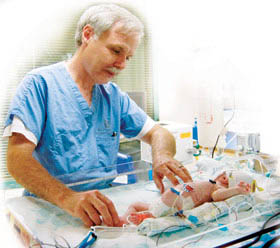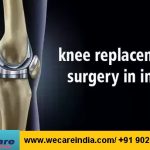CONGENITAL HEART SURGERY IN INDIA
 Congenital means inborn or existing at birth. A congenital heart defect is a malformation of the heart existing at birth. This defect results from the failure of the heart or major blood vessel to mature normally during gestation.
Congenital means inborn or existing at birth. A congenital heart defect is a malformation of the heart existing at birth. This defect results from the failure of the heart or major blood vessel to mature normally during gestation.
Congenital heart disease affects twenty five to thirty thousand children a year. That is eight out of every 1000 birth each year. Medical and surgical treatment now offers these children an opportunity to grow and mature into adult life, an option that once was not available.
Heart defects that are fixed during surgery are grouped into two categories: open and closed. Closed heart surgery implies that the “heart lung machine” or “bypass” machine is not used and the heart is visualized but not cut open. Open heart surgery implies that the heart needs to be opened in order to repair the defect and therefore the “bypass” machine is used to oxygenate and circulate the blood without using the heart or lungs. This bypass machine is used so that open heart procedures can be performed safely.
How Are Congenital Heart Defects Treated?
Although many children who have congenital heart defects don’t need treatment, some do. Doctors repair congenital heart defects with catheter procedures or surgery.
The treatment your child receives depends on the type and severity of his or her heart defect. Other factors include your child’s age, size, and general health.
Some children who have complex congenital heart defects may need several catheter or surgical procedures over a period of years, or they may need to take medicines for years.
Diagnosis in India
To find or confirm congenital heart disease, Mayo doctors have the following menu of tests at their disposal: –
- History and physical exam : –Much can be learned about the cause of symptoms by finding out about childhood, family medical history, and previous tests, diseases, and operations that have occurred. A physical examination also gives the doctor information about present cardiovascular condition.
- Chest X-ray : –A noninvasive X-ray photograph of the heart and lungs shows the size, shape, and position of the heart and possible abnormalities.
- Electrocardiogram : – Another noninvasive test that measures electrical signals created by the heart muscle as it beats.
- Echocardiogram : – This test uses sound waves (ultrasound) to assess the structure of the heart and blood flow through the heart. Mayo Clinic is a world leader in “echo” testing and performs more echo exams than any other medical center, more than 1,000 each week. At Mayo, echo exams are reviewed by physicians while the patient is being tested to ensure that the right information is collected. Because of their expertise, Mayo doctors are able to diagnose most heart problems with ultrasound, avoiding the need for invasive heart catheterization for the vast majority of patients.
- Exercise test : – Depending on what the doctor needs to know, this test can show the pumping capacity and efficiency of the heart. Blood oxygen levels may also be monitored during the test.
- Heart catheterization : – Under a local anesthetic, the patient lies on an X-ray table while a thin, flexible tube (catheter) is threaded through one of the veins and into the heart. Dye is injected into the heart chambers to allow doctors to see blood flow patterns and find heart defects. They can also close a hole or enlarge a narrowing during this procedure. Mayo performs more than 9,000 catheterizations each year for diagnosis and treatment.
- Electrophysiology study : – This study, similar to heart catheterization, measures the heart’s electrical activity from within the heart.
- Magnetic Resonance Imaging : –MRI helps to define the anatomy of the heart and great vessels. It is also used to evaulate heart size and function.
Surgery in India
A child may need open-heart surgery if his or her heart defect can’t be fixed using a catheter procedure. Sometimes, one surgery can repair the defect completely. If that’s not possible, the child may need more surgeries over months or years to fix the problem.
Open-heart surgery may be done to : –
- Close holes in the heart with stitches or with a patch
- Repair or replace heart valves
- Widen arteries or openings to heart valves
- Repair complex defects, such as problems with where the blood vessels near the heart are located or how they developed
Rarely, babies are born with multiple defects that are too complex to repair. These babies may need heart transplants. In this procedure, the child’s heart is replaced with a healthy heart from a deceased child that has been donated by that child’s family.





